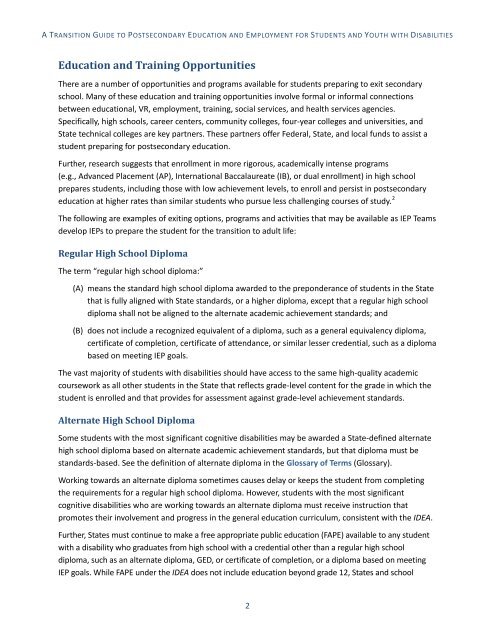TRANSITION GUIDE
2j9tM4H
2j9tM4H
Create successful ePaper yourself
Turn your PDF publications into a flip-book with our unique Google optimized e-Paper software.
A <strong>TRANSITION</strong> <strong>GUIDE</strong> TO POSTSECONDARY EDUCATION AND EMPLOYMENT FOR STUDENTS AND YOUTH WITH DISABILITIES<br />
Education and Training Opportunities<br />
There are a number of opportunities and programs available for students preparing to exit secondary<br />
school. Many of these education and training opportunities involve formal or informal connections<br />
between educational, VR, employment, training, social services, and health services agencies.<br />
Specifically, high schools, career centers, community colleges, four-year colleges and universities, and<br />
State technical colleges are key partners. These partners offer Federal, State, and local funds to assist a<br />
student preparing for postsecondary education.<br />
Further, research suggests that enrollment in more rigorous, academically intense programs<br />
(e.g., Advanced Placement (AP), International Baccalaureate (IB), or dual enrollment) in high school<br />
prepares students, including those with low achievement levels, to enroll and persist in postsecondary<br />
education at higher rates than similar students who pursue less challenging courses of study. 2<br />
The following are examples of exiting options, programs and activities that may be available as IEP Teams<br />
develop IEPs to prepare the student for the transition to adult life:<br />
Regular High School Diploma<br />
The term “regular high school diploma:”<br />
(A) means the standard high school diploma awarded to the preponderance of students in the State<br />
that is fully aligned with State standards, or a higher diploma, except that a regular high school<br />
diploma shall not be aligned to the alternate academic achievement standards; and<br />
(B) does not include a recognized equivalent of a diploma, such as a general equivalency diploma,<br />
certificate of completion, certificate of attendance, or similar lesser credential, such as a diploma<br />
based on meeting IEP goals.<br />
The vast majority of students with disabilities should have access to the same high-quality academic<br />
coursework as all other students in the State that reflects grade-level content for the grade in which the<br />
student is enrolled and that provides for assessment against grade-level achievement standards.<br />
Alternate High School Diploma<br />
Some students with the most significant cognitive disabilities may be awarded a State-defined alternate<br />
high school diploma based on alternate academic achievement standards, but that diploma must be<br />
standards-based. See the definition of alternate diploma in the Glossary of Terms (Glossary).<br />
Working towards an alternate diploma sometimes causes delay or keeps the student from completing<br />
the requirements for a regular high school diploma. However, students with the most significant<br />
cognitive disabilities who are working towards an alternate diploma must receive instruction that<br />
promotes their involvement and progress in the general education curriculum, consistent with the IDEA.<br />
Further, States must continue to make a free appropriate public education (FAPE) available to any student<br />
with a disability who graduates from high school with a credential other than a regular high school<br />
diploma, such as an alternate diploma, GED, or certificate of completion, or a diploma based on meeting<br />
IEP goals. While FAPE under the IDEA does not include education beyond grade 12, States and school<br />
2


